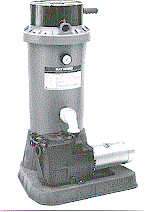DE
FILTERS
OPERATION & TROUBLE SHOOTING

Many pool professionals consider DE
filtration to be the best, because it is capable of filtering out smaller
particles than either cartridge or sand.
How clean must swimming pool water be? Any of the other types of filters can
produce clear water, but for those that want the purest and most sparkling, the
choice is DE. DE is short for diatomaceous earth a porus powder made from the
skeletons of billions of microscopic animals that died and were buried in
deposits millions of years ago. Magnified many times, they resemble small
sponges or pieces of wood that have been eaten by termites or carpenter ants.
Clear water can pass through the microscopic openings, but particles larger than
one to three microns will be trapped.
Unlike sand and cartridge filters--which may vary in outward appearance but are
identical in operation --DE filters differ in methods of operation. The type
with which this writer is familiar, the HAYWARD PERFLEX ® FILTER, uses
vertical, flexible, porous Flex Tubes as the internal elements. This will be the
type referred to in discussing operations, but all types of DE filters have
internal elements that are coated in some manner with DE.
When water containing DE passes through each of these elements, a thin, even coating of DE forms on the outside of the elements through which water circulates. The term for this is "pre-coating". It is this "filter cake" that strains the dirt, dust, algae and some forms of bacteria from the water. Just one pass through the "cake" clarifies the water to sparkling cleanliness. DE filters, no matter which type used, will clean water down to one to three microns. It is important to remember this, because all DE filters sometimes are faulted for short cycling, or clogging up too quickly. When this happens, it is because the filter is doing its job -- trapping pool contaminants one to three microns or larger.
INITIAL STARTUP Close the filter drain or plug
if the filter has one. open the suction and return valves if they exist. Close
any vent valve on the filter tank. Prime and start the pump, following the
manufacturer's instruction. Air trapped in the system will be vented into the
pool, so there is no need to open anymanual air vents. When there is a steady
flow of waater returning to the pool, the filter is ready for precoating. Do
not run the filter for more than one minute without the precoat charge.
PRECOATING - Scoop the proper amount of DE
filter powder into the system thru the skimmer, as fast as the plumbing will
take it. Note and remember the pressure reading after the DE has been added.
This is the "precoat pressure"
FILTRATION -Filtration starts as soon as the filter
has been precoated. As the filter removes dirt from pool water, the accumulated
dirt causes a resistance to flow. As the dirty water from the pool filters
through the DE cake, dirt collects on its outside surface. After several days,
or when the pressure rises 7 to 10 lbs above the precoat pressure, the
accumulated dirt begins to block the DE, diminishing the filters outflow.
BUMPING - Filtration is restored to near original
flow by a process called regeneration (Bumping), in which the clogged cake is
removed from the elements, mixed thoroughly internally, and then reapplied to
the elements. To "Bump" the filter, turn the pump off, open the vent
valve, move the handle down slowly then up briskly. Repeat 3 times. Close the
vent valve on the tank, restart the pump and filtration will resume at near the
original flow and pressure. This distributes the dirt within the DE and provides
a fresh outer filtering surface. The filter can be regenerated whenever you need
maximum filter flow, such as when vacuuming or during and after heavy pool
usage.
CLEANING - Eventually, usually after three to
ten weeks of operation the filter will need cleaning and a fresh supply of DE.
When the pressure rises more than 10 psi in less than a 24 hour period (If the
pool is not extremely dirty), simply switch off the pump, " bump off"
the filter cake, open the drain valve and allow the dirt and old DE to drain
out. No disassembly is required, and the complete operation takes about five
minutes (Follow instructions in the owner's manual).
Here are some "Don'ts" to remember when operating DE filters:
- Don't operate the filter without DE, even for very short periods.
- Don't use any DE subsititute.
- Don't attempt to "bump" with pump running.
- Don't allow pH to fall below 7.2 or rise above 7.8.
- Don't allow the chlorine to fall below 0.5 ppm for non-stabilized chlorine or 1.5 for stabilized chlorine.
- Don't use any kind of coagulants or flocculants.
- Don't use Bacquacil.